While you probably won’t encounter a dangerous sea creature on your way to school (although, I totally want to go to school with you if you do), they are still awesome creatures to learn more about.
The top 7 most poisonous and venomous sea creatures include the Box Jellyfish, Portuguese Man O’War, and Blue-Ringed Octopus. You also want to stay away from the Cone Snail, Stone Fish, Puffer Fish, and Sea Krait.
In this article, I’ll tell you fun facts about these cool creatures and why their poison or venom shouldn’t scare you off from learning all about them. While they aren’t the only poisonous/dangerous sea creatures in the deep blue, they are my top 7 picks.
Box Jellyfish

Box jellyfish normally live in the Great Barrier Reef down under in Australia. If you didn’t know, you can actually see the Great Barrier Reef from space!
Box jellyfish are covered in nematocysts, which are like tiny darts filled with poison. If a box jellyfish were to sting you, you could become paralyzed or even die. Thankfully, only some species of box jellyfish have a lethal sting to humans.
As a cool fact, box jellyfish have 24 eyes of four different types, but scientists don’t know why they have so many. The extra eyes come in handy for navigation.
The scientific name for the box jellyfish is Cubozoa.
Portuguese Man O’War

Portuguese man o’war are hydroids and they are made up of a colony of four kinds of polyp. If one of them was out of the group, they likely wouldn’t survive.
It got its name because it looks like a Portuguese warship and its venom is almost as toxic as a cobra’s venom, so you don’t want to pick one up if you see it on the beach.
Portuguese man o’war are usually found in the Atlantic and the Indian Oceans. In addition, the largest ones are usually found in late March or early April.
Finally, the tentacles of a Portuguese man o’war, which are fifty feet long, can still sting even after the colony has died. This is another reason why you shouldn’t touch one you find on the beach. Even a loose tentacle washed up can still sting you if you touch it.
The scientific name for the Portuguese man o’war is Physalia physalis.
Blue-Ringed Octopus

The Blue-Ringed Octopus is found in the Pacific and Indian oceans and often live in coral reefs and tide pools. It is one of the most venomous animals you can come across.
The octopus can change colors to camouflage and will bite if threatened. They also will show off around sixty iridescent blue rings once disrupted. In addition, these rings are telling a predator to stay away.
Thankfully, fatal bites are rare from a blue-ringed octopus, however, you never want to approach one if you see it along the beach.
Finally, despite the strength of their venom, a blue-ringed octopus is only about eight inches tall!
The scientific name for the blue-ringed octopus is Hapalochlaena.
Cone Shell
You will find cone shells in the tropical waters of the Pacific and Indian oceans. Cone shells, also called cone snails, use their harpoon-like teeth to paralyze their prey, which they swallow whole. Most cone shells eat worms, fish, or other snails.
Cone shells are often picked up because of their beautiful appearance; however, people should steer clear of cone shells because they can be lethal within 15 minutes.
Humans usually get speared by cone shells if they step on one in the ocean or are picked up. In addition, once contact is made, cone shells begin quickly jabbing their prey to shoot their toxic venom.
The scientific name for the cone shell is Conidae.
Stonefish

Stonefish are the most poisonous fish on earth, and their lethal venom can be fatal to both humans and other sea creatures.
Humans need to be careful not to step on a stonefish because the spines are sharp enough to go through a rubber-soled shoe.
Finally, stonefish are hard to see on the ocean floor because they blend in with pieces of mud, coral, and algae. However, they raise the spines on their back if they feel threatened. The sharp spines will inject poison into its predator.
The scientific name for stonefish is Synanceia.
Puffer Fish

There are many species of pufferfish, including the common pufferfish, bandtail pufferfish, and porcupine fish.
Pufferfish can expand their bodies 2-3 times bigger than their standard size. To do this, pufferfish ingest large amounts of water and sometimes air to create a puffed-up look.
While pufferfish don’t use their poison as a defense, they have enough internally to kill up to thirty adults! Interestingly, a pufferfish’s toxins are more poisonous to humans than animals.
Pufferfish eat sea stars, crabs, and other shellfish by using their beak-like mouths to crush the food. Humans should keep their fingers far away from their mouths! Their sharp “beak” can bite a human’s finger off!
Finally, while some people in other countries eat pufferfish, chefs remove the poisonous parts to make them edible.
The scientific name for pufferfish is Tetraodontidae.
Banded Sea Krait

Banded sea kraits are sea snakes found in coral reefs along the western Pacific and eastern Indian oceans.
Sea kraits are more poisonous than any land snake you’ll encounter. The sea snake uses their potent venom to paralyze their prey before swallowing it whole.
In addition, while sea kraits can hold their breath for a while, they come to shore and lay on rocks to digest their food.
Thankfully for us, sea kraits pose a minor threat to humans and sometimes won’t bite even if they feel threatened.
The scientific name for Banded Sea Krait is Laticauda colubrina.
That’s a (Poisonous) Wrap!
There you have it! You just learned about the 7 most poisonous sea creatures. While they seem threatening, there’s a slight chance you will encounter them on your beach trip.
However, it’s fun to learn more about these exciting creatures and understand more about them.
To recap, the most poisonous and venomous sea creatures are:
- Box jellyfish
- Portuguese Man O’ War
- Blue-Ringed Octopus
- Cone Snail
- Stone Fish
- Puffer Fish
- Sea Krait
I hope you enjoyed this list! Feel free to send me a message with your idea for my next article! Thank you for reading!
References
Clench, William J., and Yoshio Kondo. “The Poison Cone Shell.” American Journal of Tropical Medicine 23.1 (1943).
Garm, Anders, Magnus Oskarsson, and Dan-Eric Nilsson. “Box jellyfish use terrestrial visual cues for navigation.” Current Biology 21.9 (2011): 798-803.
Lane, Charles E. “The Portuguese man-of-war.” Scientific American 202.3 (1960): 158-171.
Mäthger, Lydia M., et al. “How does the blue-ringed octopus (Hapalochlaena lunulata) flash its blue rings?.” Journal of Experimental Biology 215.21 (2012): 3752-3757.